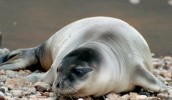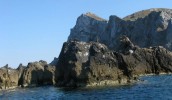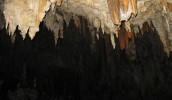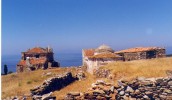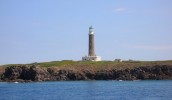Overview of the Marine Park
The National Marine Park of Alonissos Northern Sporades was the first marine area of Greece that was characterized as a “Marine Park” and the largest in the Mediterranean. It was enacted by Presidential Decree (Government Gazette 519 / D ‘/ 1992) which was updated with the J.M.D. 23537/2003 (Government Gazette 621 / D’/ 2003). The purpose of the creation of the “National Marine Park” was the protection, conservation and management of nature and landscape, as a natural heritage and valuable national natural resource, due to its great biological, ecological, aesthetic, scientific, geomorphological and pedagogical value. In addition to the many rare species of flora, fauna and natural formations, in the Sporades area live and reproduce a significant population of the Mediterranean seal Monachus monachus, a species that has been defined as the number 1 endangered marine mammal.
National Marine Park of Alonissos and Northern Sporades
The National Marine park of Alonissos and Northern Sporades is the nature reserve for a series of terrestrial and marine species living in the Mediterranean Sea, including hundreds of plants and animals, as well as remarkable archaeological and historical monuments.
From both a scientific and a cultural point of view, this is an area of great interest given the archaeological finds (shipwrecks, old monasteries and churches) dating back to the prehistoric era, the classical period or the Byzantine Empire.
Visitors are welcome to enjoy swimming and diving, take pictures, record videos, go sightseeing, walk around or observe the wildlife in areas where public access is permitted.
There are also specific marine areas where fishing is allowed for amateur fishermen. Hunting is allowed only on the island of Gioura, subject to special permission.
The Management Agency of N.M.P.A.N.S
With the integration in Natural Environment and Climate Change Agency (NECCA) of the Management Body of National Marine Park of Alonissos-Northern Sporades , the Management Unit of Sporades National Park operates under N.E.C.C.A.’s Protected Areas Management Directorate (Sector A), based in Alonissos.
For detailed information on the specific regulations that are in effect to N.M.P.A.N.S. the visitor is advised to contact the Management Body of the Marine Park in Patitiri, which is the competent authority for giving permits to enter the Park as well as permissions for activities within the Park. Next to the Management Body’s office there is also the Information Center.
For more detailed information please check the official website of NECCA
For access to the Zone A of the Park a ticket is necessary, please check here https://tickets.alonissos-park.gr/checkout
For any clarification, please contact the offices of the Management Body of N.M.P.A.N.S. on the phones 0030 2424066419 and on the e-mail : mdpp.sporades@necca.gov.gr
The islands
Alonissos
Alonissos is a hilly island with low mountains (493m max.) that either form steep coasts in the northern part or small plains in the eastern part of the island, respectively. The southern part of the island is spread with pine forests that stand in sharp contrast to the macchia vegetation, pistacias and arbutuses common in the northern part.
Local population totals 3,000 permanent residents approximately; following a period of internal and external migration, current vital statistics show a small yet stable population growth during the last decades. Agriculture, cattle-raising and fishing are the main sources of income for locals; in recent years, tourism also seems to be growing on the island. The National Marine Park of Alonissos and Northern Sporades is expected to play a significant role in the sustainable development of this region, providing new job opportunities and supporting local traditional professions.
The majority of local population lives in Patitiri village, which is also the central port of the island. Patitiri is the administrative centre of Alonissos and the place where all public services are concentrated. Votsi and Roussoum Yalos bay both lie to the north of the port. Modern Patitiri village used to be a port servicing the old mountain village of Alonissos (Old Village). In 1965, a destructive earthquake forced all inhabitants of the Old Village to leave their homes and move to the port of Patitiri. The new village was named after the winepresses (patitiria) that locals used in the wine-making process.
From the port of Patitiri, day boating tours set off daily to many local beaches, as well as the neighbouring islands of the Marine Park where public access is allowed (Zone A).
In the north-eastern part of Alonissos lies the small natural port of Steni Vala. Serving as a refuge for fishing boats and crafts, Steni Vala is a lovely resort where visitors can find excellent quarters at apartments or rooms to let and enjoy good food at local taverns. The Rescue and Rehabilitation Centre for wounded and orphaned baby seals, run by MOm, is also found in this part of the island.
Peristera
Peristera is an uninhabited island spread with macchia vegetation. Underwater archaeological research has brought to light an old shipwreck along with a series of other archaeological finds revealing that Sporades Islands had always been an important sea route for ancient cultures. Therefore, one of the primary goals set by the National Marine Park consists in preserving these archaeological finds and making them known to the world in cooperation with local authorities.
Kira-Panagia
In the northern part of the Marine Park, the first island to come across is Kira-Panagia. Mountainous and uninhabited, this island has a smooth surface and is spread with macchia vegetation, pistacias (Pistacia lentiscus) and kermes oaks (Quercus coccifera).
Two shallow bays, Agios Petros and Planitis, are found in the southern and northern part of the island to provide a natural safe refuge for boats and crafts. In the eastern part of the island, there is a Monastery dedicated to the birth of Virgin Mary. Recently reconstructed, this monastery dates back to the meta-Byzantine period.
Gioura
Heading northeast, Gioura is the next uninhabited isle to come across within the Marine Park. Gioura is a rocky and precipitous island giving shelter to many indigenous wildlife species. More specifically, a rare goat species - largely considered as indigenous - lives on this island. A popular destination on the island is the Cyclops’s cave with beautiful stalagmite and stalactite structures. Gioura and its caves provide a living place to the Mediterranean monk seal and therefore, the island has been declared a nature reserve.
Psathoura
Psathoura is the most northerly island of the Marine Park. In sharp contrast to the rest of the islands, its landscape is dominated by volcanic features, spread with heathers and other bushes. Plant species unknown to the rest of Marine Park islands are common here, such as the sea daffodil (Pancratium maritunum). In the southern part of the isle, Mandraki beach stands out within the dark rocky landscape for its fine white sand. Walking to the northern part, you can’t miss the large lighthouse built by French engineers in the previous century, signalling the international sea routes of the Northern Aegean Sea.
Piperi
Piperi Island is the heart of the Marine Park and therefore, a strictly protected area. It is the most important nature reserve of the Mediterranean monk seal and many raptors that live and reproduce on its steep cliffs. Rare plant species, pine forests, kermes oaks, phrygana, pistacias and plants growing on cliffs are common here. There are up to 33 bird species and approximately 350 to 400 pairs of Eleonora’s falcons (Falco eleonorae).
Skantzoura
Skantzoura is a hilly island with white marble cliffs going deep under the sea. It used to be the monastic centre of the wider region. It is spread with Macchia vegetation, phrygana and short cedars (Juniperus sp.). Along with Strogilo and Polemica (its two neighbouring isles), Skantzoura is an important nature reserve of seagulls (Larus audouinii) and Eleonora’s falcons (Falco eleonorae).





